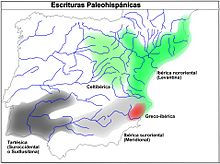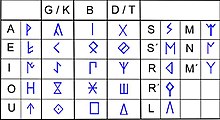Northeast Iberian script

The Northeast Iberian script , also known as the Iberian script , is one of several closely related syllabic scripts in the ancient Hispanic scripts that were used on the Iberian Peninsula before and at the beginning of Roman rule .
application
The Northeast Iberian script was used in the fourth to last century BC in the northeast of the Iberian Peninsula to record the language of the Iberians .
Characteristic
The characters are partly open syllables made up of plosive sounds and vowels , and some are single sounds . It is unclear whether they go back to Phoenician models directly or indirectly via Greek letters . Most of the writing was written from left to right. There is an older variant (4th and 3rd centuries) that distinguishes between voiced and unvoiced plosives, and a younger variant that does not. The Northeast Iberian script is the best-researched of the pre-Roman syllabary scripts on the peninsula.
Related writings
Celtiberian script
An only slightly modified form was tailored to the requirements of the Celtiberian language and is known as the Celtiberian script .
Southeast Iberian script
The Southeast Iberian script was used in what is now Andalusia. It has only been incompletely researched.
South lusitan script
The South Lusitan script (Tartessian or Southwestern script) is very similar to the Southeast Iberian script.
Graeco-Iberian alphabet
The Graeco-Iberian alphabet , used in today's provinces of Murcia and Alicante , was also used to record the language of the Iberians, but was only a slightly modified Greek alphabet , i.e. not a syllabary. It was always written from left to right.
literature
- José Antonio Correa: Los semisilabarios ibéricos: algunas cuestiones . In: ELEA . 4, 2004, ZDB -ID 252258-5 , pp. 75-98.
- Joan Ferrer i Jané: Novetats sobre el sistema dual de diferenciació gràfica de les oclusives sordes i sonores ( Memento of February 15, 2012 in the Internet Archive ) (PDF; 244 kB) . In: Palaeohispanica . 5, 2005, ISSN 1578-5386 , pp. 957-982.
- Javier de Hoz Bravo: The recepción de la escritura en Hispania como fenómeno orientalizante . In: Sebastián Celestino Pérez (ed.): El periodo orientalizante . Actas del III Simposio Internacional de Arqueología de Mérida - Protohistoria del Mediterráneo Occidental. Volume 1. Consejo Superior de Investigaciones Científicas, Madrid 2005, ISBN 84-00-08346-6 , pp. 363-380 ( Anejos de Archivo Español de Arqueología 35).
- Michel Lejeune : D'Alcoy a Espanca. Reflections on the écritures paleo-hispaniques . In: Michel Lejeune: Notice biographique et bibliographique . Center International de Dialectologie Générale, Leuven 1993, ISBN 2-87723-102-X , pp. 53-86 ( Biobibliographies et exposés 3).
- Jesús Rodríguez Ramos: Análisis de epigrafía íbera . Universidad del País Vasco et al., Vitoria-Gasteiz 2004, ISBN 84-8373-678-0 , ( Veleia Anejos Series minor 22).
- Ulrich Schmoll: The Sudlusitanian inscriptions . Harrassowitz, Wiesbaden 1961.
-
Jürgen Untermann (Ed.): Monumenta Linguarum Hispanicarum . Reichert, Wiesbaden,
- Volume 1: The Coin Legends . 1975, ISBN 3-920153-53-7 ,
- Volume 2: The Iberian Inscriptions from the South of France . 1980, ISBN 3-88226-098-X ,
- Volume 3: The Iberian Inscriptions from Spain . 1990, ISBN 3-88226-491-8 ,
- Volume 4: The Tartessian, Celtiberian and Lusitan Inscriptions . 1997, ISBN 3-88226-892-1 .
- Javier Velaza: La escritura en la península ibérica antigua . In: J. Bartolomé: La escritura y el libro en la antigüedad . Sociedad Española de Estudios Clásicos et al., Madrid 2004, ISBN 84-7882-547-9 , pp. 95-114.




